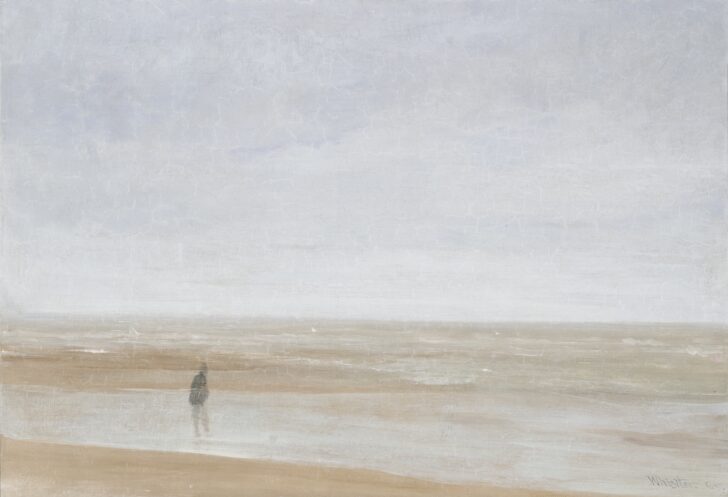Sea and Rain
James Abbott McNeill Whistler

Description
James McNeill Whistler
United States, 1834–1903
Sea and Rain
1865
Oil on canvas
University of Michigan Museum of Art, Bequest of Margaret Watson Parker, 1955/1.89
During the late summer of 1865, Gustave Courbet and Whistler, whose early training and orientation as a painter had been in the realist style, spent some weeks at the fashionable seaside resort town of Trouville, accompanied by Whistler’s mistress Joanna Hiffernan. Years later, Courbet recalled fondly the time the trio spent at Trouville and claimed the youthful Whistler as a student—an assertion that Whistler vigorously denied. The mature Courbet, whose canvases show paint thickly laid in with a palette knife, could not have contrasted more sharply with the approach of the younger American painter, whose canvases evidence a thinner and more gossamer surface.
Both Courbet and Whistler painted marine views during this sojourn to the Atlantic shore. Whereas the older artist’s seascapes tend to emphasize dramatic elements of the coast—breaking waves and billowing clouds—Whistler’s work had already begun to depart from the tenets of realism in favor of a more evanescent and aesthetic response to the motif of the sea. The understated depiction of the water on a misty and overcast day is quite different from Courbet’s more muscular portrayals from this date.
(Normandy show, 2010)
Subject Matter:
Whistler accompanied the Realist painter Gustave Courbet in a late summer painting campaign along the Normandy coast, in the resort town of Trouville. Although Whistler had embraced the tenets of Realism early in his career, by 1865 he had begun to evolve his own painting style that departed from the vigorous brushwork and heavy impasto of Courbet's example. This work, painted in the older artist's company, exhibits Whistler's characteristic thin veils of paint that evoke the atmosphere along the coastline rather than minutely describe it. The presence of the man implies no narrative story but is a precisely placed accent within the composition. Whistler's credo of "art for art's sake" has already shaped how he portrays a cloudy day at a summer retreat.
Physical Description:
The painting depicts a solitary male figure standing along the shore. The thin layers of paint evoke a misty, overcast day with the figure standing perhaps on a tidal flat.
Usage Rights:
If you are interested in using an image for a publication, please visit https://umma.umich.edu/request-image/ for more information and to fill out the online Image Rights and Reproductions Request Form.